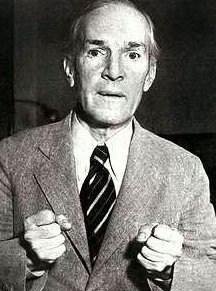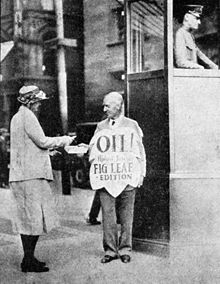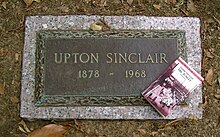
Information to change the world | |
Find Topics, Titles, Names related to your query |

Information to change the world | |
Find Topics, Titles, Names related to your query |
|
|
Upton Sinclair
|
||||||||||||||||||||
| This article needs additional citations for verification. Please help improve this article by adding reliable references. Unsourced material may be challenged and removed. (January 2009) |
| Upton Sinclair | |
|---|---|
 |
|
| Born | September 20, 1878 Baltimore, Maryland |
| Died | November 25, 1968 (aged 90) Bound Brook, New Jersey |
| Occupation | Novelist, writer, journalist, political activist |
| Nationality | American |
Upton Sinclair, Jr. (September 20, 1878 – November 25, 1968), was a Pulitzer Prize-winning American author who wrote over 90 books in many genres. He achieved popularity in the first half of the 20th century, acquiring particular fame for his 1906 muckraking novel The Jungle. It exposed conditions in the U.S. meat packing industry, causing a public uproar that contributed in part to the passage a few months later of the 1906 Pure Food and Drug Act and the Meat Inspection Act.[1]
Contents |
Sinclair was born in Baltimore, Maryland to Upton Beall Sinclair and Priscilla Harden. His father was a liquor salesman whose alcoholism shadowed his son's childhood. Sinclair had wealthy grandparents with whom he often stayed. This gave him insight into how both the rich and the poor lived during the late nineteenth century. Living in two social settings affected him greatly and highly influenced his novels. In 1888, the Sinclair family moved to the Bronx, where Sinclair entered the City College of New York at the age of thirteen, writing novels and magazine articles to pay for his tuition. He graduated in 1897 and then studied for a time at Columbia University.[2]
Sinclair married his first wife, Meta Fuller, in 1902.
In 1904 Sinclair spent seven weeks in disguise, working undercover in Chicago's meatpacking plants to research his fictional expos, The Jungle. When it appeared in 1906, it became a bestseller. With the income from The Jungle, Sinclair founded the utopian Helicon Home Colony in Englewood, New Jersey and ran as a Socialist candidate for Congress.[3][4] The colony burned down under suspicious circumstances within a year.[5]
Around 1911, Meta left Sinclair for the poet Harry Kemp, later known as the Dunes Poet of Provincetown, Massachusetts. Sinclair then married Mary Craig Kimbrough (1883–1961), a woman who was later tested for psychic abilities. In these years Sinclair wrote or produced several films. Recruited by Charlie Chaplin, he and his wife Mary produced Eisenstein's –¡Qu viva Mxico! in 1930-32.[6][7][8][9]
After Mary Craig Kimbrough's death in 1961, Sinclair married Mary Elizabeth Willis (1882–1967). He moved to California in the 1920s and late in life moved to Buckeye, Arizona and then to Bound Brook, New Jersey. Sinclair died there in a nursing home on November 25, 1968.[10] He is buried in Rock Creek Cemetery in Washington, D.C., next to his third wife, who died a year before him.


Aside from his political and social writings, Sinclair took an interest in psychic phenomena and experimented with telepathy, writing a book entitled Mental Radio which appeared in 1930.[11][12]
The Upton Sinclair House in Monrovia, California, is now a National Historic Landmark. The papers, photographs, and first editions of most of Sinclair's books are found at the Lilly Library at Indiana University in Bloomington, Indiana.[13]
In the 1920s Sinclair moved to Monrovia, California, where he founded the state's chapter of the American Civil Liberties Union. He moved to Southern California with an interest in politics, twice running unsuccessfully for Congress on the Socialist ticket: in 1920 for the House of Representatives and in 1922 for the Senate.
Sinclair ran in the 1934 California gubernatorial election as a Democrat. With 879,000 votes, this was his most successful run for office, though he was still defeated by a sizable margin.[14] Sinclair's platform, known as the End Poverty in California movement (EPIC), galvanized the support of the Democratic Party, and Sinclair gained its nomination.[15]
Severe dust storms during the period made farming on the Great Plains impossible, and hundreds of thousands of Southern and Great Plains residents were forced to migrate westward in the hope of finding work and a new life. Upton Sinclair's plan to end poverty quickly became a controversial issue. Conservatives in California saw it as an attempted communist takeover of their state and were galvanized in opposition. They used widespread political propaganda that portrayed Sinclair as a staunch communist, even though American and Soviet communists disassociated themselves from him as a capitalist. Science fiction author Robert A. Heinlein was deeply involved in Sinclair's campaign, a point that Heinlein tried to obscure in later biographies, as he tried to keep his personal politics separate from his public image as an author.[16]
Sinclair lost to Frank F. Merriam in the election and largely abandoned EPIC and politics to return to writing. However, the race of 1934 became known as the first race to use modern campaign techniques like motion pictures.[citation needed] In 1935 Sinclair published I, Candidate for Governor: And How I Got Licked, in which he detailed the techniques employed by Merriam's supporters, such as the oratory of Aimee Semple McPherson, who vehemently opposed socialism and what she perceived as Sinclair's modernism, in spite of the fact that both she and Sinclair had supported prohibition.
Of his gubernatorial bids, Sinclair remarked in 1951: "The American People will take Socialism, but they won't take the label. I certainly proved it in the case of EPIC. Running on the Socialist ticket I got 60,000 votes, and running on the slogan to 'End Poverty in California' I got 879,000. I think we simply have to recognize the fact that our enemies have succeeded in spreading the Big Lie. There is no use attacking it by a front attack, it is much better to out-flank them."[17]
Sinclair devoted his writing career to documenting and criticizing the social and economic conditions of the early twentieth century. He exposed his view of the injustices of capitalism and the overwhelming impact of the poverty.
In The Jungle (1906), Sinclair gave a scathing indictment of unregulated capitalism as exemplified in the meatpacking industry. His descriptions of both the unsanitary conditions and the inhumane conditions experienced by the workers shocked and galvanized readers. Domestic and foreign purchases of American meat fell by half.[18] The novel carried such influence that it spurred government regulation of the industry, as well as the passage of the Pure Food and Drug Act.
Between 1940 and 1953, Sinclair wrote a series of 11 novels featuring a central character named Lanny Budd, the son of an American arms manufacturer who moved in the confidence of world leaders, not simply witnessing events but often propelling them. The protagonist has been characterized as the antithesis of the "Ugly American", a sophisticated socialite who mingles easily with people from all cultures and socioeconomic classes.[19]
The series covers in sequence much of the political history of the Western world, particularly Europe and America, in the first half of the twentieth century. Almost totally forgotten today, the novels were all bestsellers upon publication and were published in 21 countries. The third book in the series, Dragon's Teeth, won the Pulitzer Prize in 1943.
The novels in the Lanny Budd series are:
Sinclair is extensively featured in Harry Turtledove's American Empire trilogy, an alternate history series in which the American Socialist Party succeeds in becoming a major force in US politics following two humiliating military defeats to the Confederate States and the post-1882 collapse of the Republican Party, with Abraham Lincoln leading a large number of Republicans into the Socialist Party. He wins the 1920 and 1924 presidential elections and becomes the first Socialist President of the United States, his inauguration attended by crowds of jubilant militants waving red flags. However, the actual policies which Turtledove attributes to him, once in power, are not particularly radical.[citation needed]
In the late 1990s, the television program Working used as its setting a company named Upton Weber. With the show's implicit criticism of contemporary working conditions, however watered down for popular audiences, the name suggests a reference both to Upton Sinclair and Max Weber.
Sinclair is featured as one of the main characters in Chris Bachelder's satirical fictional book, U.S.!: a Novel. Repeatedly, Sinclair is resurrected as a personification of the contemporary failings of the American left and portrayed as a quixotic reformer attempting to stir an apathetic American public to implement socialism in America.
The Jungle (1906) was adapted for film in 1914.[20] Sinclair appears at the beginning and end of the film "as a form of endorsement."[21]
The Wet Parade (1931) became a film directed by Victor Fleming in 1932. It starred Robert Young, Myrna Loy, Walter Huston, and Jimmy Durante.[22]
The Gnomobile (1937) was the basis of a 1967 Disney musical motion picture, The Gnome-Mobile.[23]
Oil! (1927) was the basis of There Will Be Blood (2007), starring Daniel Day-Lewis and Paul Dano. It was written, produced, and directed by Paul Thomas Anderson. The film received eight Oscar nominations and won two.[24]
Fiction
Autobiographical
Non-fiction
Drama
As editor
| Wikiquote has a collection of quotations related to: Upton Sinclair |
| Wikisource has original works written by or about: Upton Sinclair |
Related topics in the Connexions Subject Index
Alternatives –
Left History –
Libraries & Archives –
Social Change –
This article is based on one or more articles in Wikipedia, with modifications and additional content contributed by
Connexions editors. This article, and any information from Wikipedia, is covered by a
Creative Commons Attribution-Sharealike 3.0 Unported License (CC-BY-SA) and the
GNU Free Documentation
License (GFDL).
We welcome your help in improving and expanding the content of Connexipedia articles, and in correcting errors. Connexipedia is not a wiki: please contact Connexions by email if you wish to contribute. We are also looking for contributors interested in writing articles on topics, persons, events and organizations related to social justice and the history of social change movements.
For more information contact Connexions



